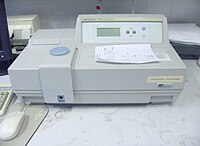
Photo from wikipedia
Abstract There has been much interest in producing natural colorants to replace synthetic colorants of health concerns. Escherichia coli has been employed to produce natural colorants including carotenoids, indigo, anthocyanins,… Click to show full abstract
Abstract There has been much interest in producing natural colorants to replace synthetic colorants of health concerns. Escherichia coli has been employed to produce natural colorants including carotenoids, indigo, anthocyanins, and violacein. However, production of natural green and navy colorants has not been reported. Many natural products are hydrophobic, which are accumulated inside or on the cell membrane. This causes cell growth limitation and consequently reduces production of target chemicals. Here, integrated membrane engineering strategies are reported for the enhanced production of rainbow colorants—three carotenoids and four violacein derivatives—as representative hydrophobic natural products in E. coli. By integration of systems metabolic engineering, cell morphology engineering, inner‐ and outer‐membrane vesicle formation, and fermentation optimization, production of rainbow colorants are significantly enhanced to 322 mg L–1 of astaxanthin (red), 343 mg L–1 of β‐carotene (orange), 218 mg L–1 of zeaxanthin (yellow), 1.42 g L–1 of proviolacein (green), 0.844 g L–1 of prodeoxyviolacein (blue), 6.19 g L–1 of violacein (navy), and 11.26 g L–1 of deoxyviolacein (purple). The membrane engineering strategies reported here are generally applicable to microbial production of a broader range of hydrophobic natural products, contributing to food, cosmetic, chemical, and pharmaceutical industries.
Journal Title: Advanced Science
Year Published: 2021
Link to full text (if available)
Share on Social Media: Sign Up to like & get
recommendations!